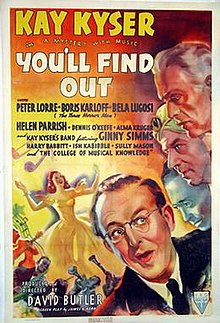| You'll Find Out | |
|---|---|
 Film poster | |
| Directed by | David Butler Fred Fleck (assistant) |
| Written by | David Butler James V. Kern Monte Brice Andrew Bennison R.T.M. Scott |
| Produced by | David Butler |
| Starring | Kay Kyser Boris Karloff Peter Lorre Bela Lugosi |
| Cinematography | Frank Redman |
| Edited by | Irene Morra |
| Music by | Roy Webb |
Production company | |
Release date |
|
Running time | 97 minutes |
| Country | United States |
| Language | English |
| Budget | $371,000 [1] |
| Box office | $1 million [1] |
You'll Find Out is a 1940 American comedy film directed by David Butler and starring Kay Kyser. In 1940, the film was nominated for an Academy Award for Best Original Song ("I'd Know You Anywhere") at the 13th Academy Awards. In the film, members of an orchestra hired to play at a young heiress's birthday party uncover a plot against her. [2] The film was very popular and made a profit of $167,000. [1]